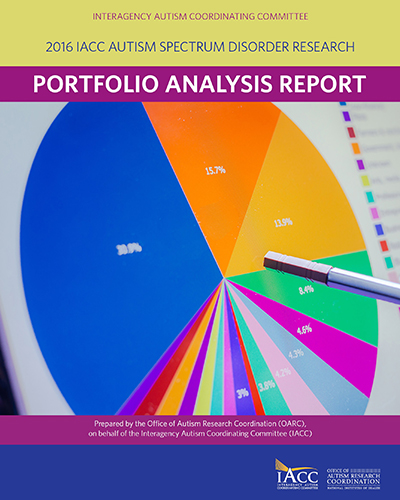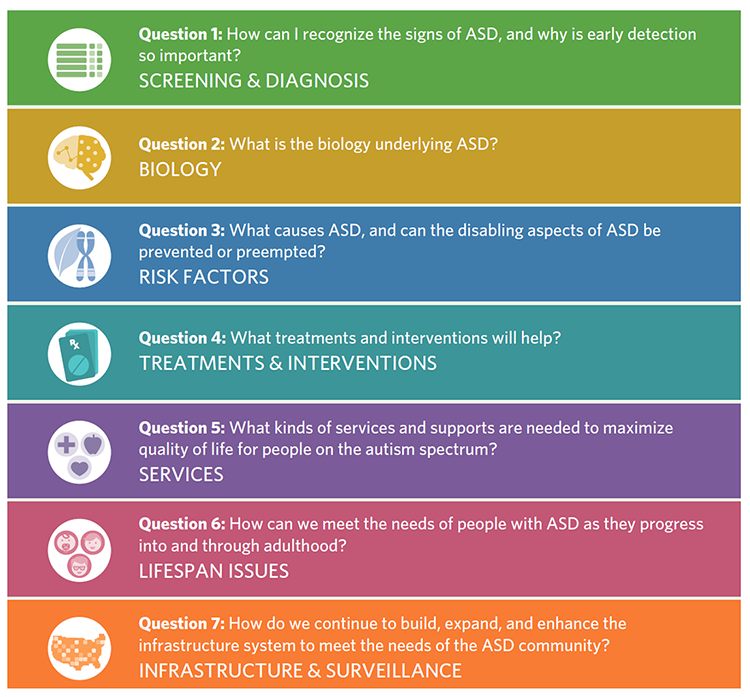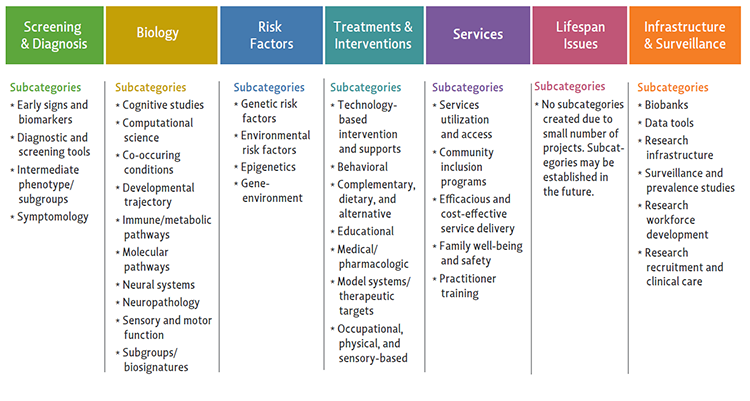Portfolio Analysis Report
IACC Autism Spectrum Disorder Research
2016
Introduction & Analysis Framework
In 2009, the Interagency Autism Coordinating Committee (IACC) produced its first Strategic Plan for Autism Spectrum Disorder Research, providing a framework to guide the efforts of federal and private funders of autism research. The IACC Strategic Plan, developed with extensive input from a broad array of federal and public stakeholders, organizes research priorities around seven general topic areas represented as community-focused “questions.” The questions are divided further into research objectives that address key research needs, gaps, and opportunities identified by the Committee. For the most recent edition, 2016-2017 IACC Strategic Plan for Autism Spectrum Disorder, the Committee agreed that given the recent advances in the autism field, it was an appropriate time to re-evaluate the autism research landscape and formulate new objectives for each question. Each question in the Strategic Plan includes three to four primary objectives; there is also one cross-cutting objective on the topic of ASD in females. The 23 new objectives on autism research and services are presented in Figure 1; for more details on the objectives and a description of the latest advances in the field represented by each question please reference the 2016-2017 Strategic Plan.
Following the development of the IACC Strategic Plan, the Office of Autism Research Coordination (OARC) – the office within the National Institutes of Health (NIH) that manages the activities of the IACC – began in 2008 issuing a series of IACC Autism Spectrum Disorder (ASD) Research Portfolio Analysis Reports to provide the IACC with comprehensive information about the status of autism research funding among federal agencies and private research organizations in the U.S. The reports align data on individual research-related projects with objectives in the IACC Strategic Plan, providing an accounting of how much funding has supported projects related to Strategic Plan objectives and highlighting trends. This information has been used to help the IACC in their efforts to monitor ASD research efforts and track progress made each year on the objectives in the IACC Strategic Plan. The 2016 Portfolio Analysis Report is the first portfolio analysis measuring progress made toward the 22 primary objectives and one cross-cutting objective in the 2016-2017 IACC Strategic . In addition to information on research progress made in 2016, the 2016 IACC ASD Research Portfolio Analysis Report also provides an analysis of progress that was made over the nine-year period from 2008-2016.
To accompany the IACC 2016 ASD Research Portfolio Analysis Report, detailed federal and private organization project data are available in the Autism Research Database (ARD), a database accessible via the IACC website (https://iacc.hhs.gov/funding/data/).This database provides stakeholders with a centralized place from which to gather valuable information about ASD research that can support their efforts to serve the autism community.
2016-2017 Strategic Plan Objectives

- Strengthen the evidence base for the benefits of early detection of ASD.
- Reduce disparities in early detection and access to services.
- Improve/validate existing, or develop new tools, methods, and service delivery models for detecting ASD in order to facilitate timely linkage of individuals with ASD to early, targeted interventions and supports.
Cross-Cutting
- Support research to understand the underlying biology of sex differences in ASD, possible factors that may be contributing to underdiagnosis, unique challenges that may be faced by girls/women on the autism spectrum, and develop strategies for meeting the needs of this population.

- Foster research to better understand the processes of early development, molecular and neurodevelopmental mechanisms, and brain circuitry that contribute to the structural and functional basis of ASD.
- Support research to understand the underlying biology of co-occurring conditions in ASD and to understand the relationship of these conditions to ASD.
- Support large-scale longitudinal studies that can answer questions about the development of ASD from pregnancy through adulthood and the natural history of ASD across the lifespan.

- Strengthen understanding of genetic risk and resilience factors for ASD across the full diversity and heterogeneity of those with ASD, enabling development of strategies for reducing disability and co-occurring conditions in ASD.
- Understand the effects on ASD risk and resilience of individual and multiple exposures in early development, enabling development of strategies for reducing disability and co-occurring conditions in ASD.
- Expand knowledge about how multiple environmental and genetic risk and resilience factors interact through specific biological mechanisms to manifest in ASD phenotypes.

- Develop and improve pharmacological and medical interventions to address both core symptoms and co-occurring conditions in ASD.
- Create and improve psychosocial, developmental, and naturalistic interventions for the core symptoms and co-occurring conditions in ASD.
- Maximize the potential for technologies and development of technology-based interventions to improve the lives of people on the autism spectrum.

- Scale up and implement evidence-based interventions in community settings.
- Reduce disparities in access and in outcomes for underserved populations.
- Improve service models to ensure consistency of care across many domains with the goal of maximizing outcomes and improving the value that individuals get from services.

- Support development and coordination of integrated services to help youth make a successful transition to adulthood and provide supports throughout the lifespan.
- Support research and implement approaches to reduce disabling co-occurring physical and mental health conditions in adults with ASD, with the goal of improving safety, reducing premature mortality, and enhancing quality of life.
- Support research, services activities, and outreach efforts that facilitate and incorporate acceptance, accommodation, inclusion, independence, and integration of people on the autism spectrum into society.

- Promote growth, integration, and coordination of biorepository infrastructure.
- Develop, enhance, and link data repositories.
- Expand and enhance the research and services workforce, and accelerate the pipeline from research to practice.
- Strengthen ASD surveillance systems to further understanding of the population of individuals with ASD, while allowing comparisons and linkages across systems as much as possible.
Figure 1. The 2016-2017 IACC Strategic Plan’s revised seven questions and 23 new objectives.
IACC Strategic Plan Questions and Corresponding Research Areas
The Office of Autism Research Coordination (OARC) requested information on 2016 autism-related research projects funded by several federal agencies and private organizations, including the annual funding amount and the relevance of each project to the seven critical questions of the 2016-2017 IACC Strategic Plan for ASD, illustrated below (Figure 2).
Figure 2. The seven questions and corresponding research areas of the 2016-2017 IACC Strategic Plan are represented by the icons to the left of each question.
Subcategory Classification
In 2010, OARC introduced the subcategory classification system (Figure 3) to the IACC Portfolio Analysis Report to help the Committee and other readers of this report better understand the types of research encompassed by the projects in the research portfolio – especially those projects that are categorized as outside the specific objectives of the Strategic Plan but within a question’s research area. For the subcategory analysis, each project in the 2016 Portfolio Analysis Report was assigned to a subcategory based on the research area it addressed. The application of subcategory coding to projects in the portfolio helped to break the portfolio into easy-to-understand topical areas. For example, within Question 1 (Screening and Diagnosis), the projects were divided into four subcategories: 1) Diagnostic and screening tools; 2) Early signs and biomarkers; 3) Intermediate phenotypes/ Subgroups and 4) Symptomology.
IACC Strategic Plan Corresponding Research Areas by Subcategory
Figure 3. A subcategory classification system was created to allow an understanding of the autism research portfolio based on simple research topics that are relevant to each of the IACC Strategic Planquestions. Appendix C provides detailed definitions of the subcategory research areas.






